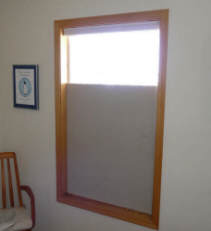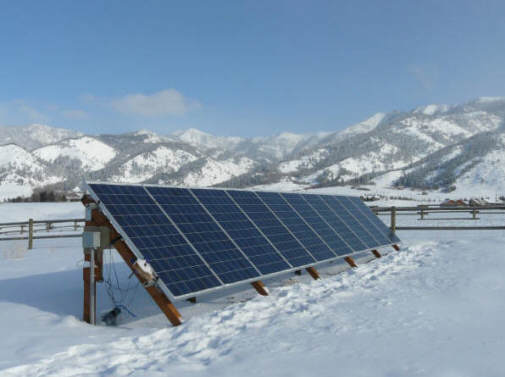
Search
The Renewable Energy site for Do-It-Yourselfers
Half Plan Update
for 2010
As you may have noticed, the charts
that show our progress on the Half Plan are out of date.
The main reasons for this are: 1) the charts are kind of a pain to keep up to
date, and 2) we have well exceeded the goal of cutting energy use in half in all
areas.
So, this is a sort of verbal update
on activities of late to try to get further down the energy curve. The way
it turns out, maybe we should have adopted one quarter instead of one half as
the target :)
I'd be very interested in hearing
from people on the Half Plan. To me, its the most important material on
the Build-It-Solar, but it does not get a whole lot of traffic. Maybe its
poorly organized? Any ideas?
contact Gary...
For all the
details on the Half Plan...
Space Heating
We just got our once a year fill up
of propane.
The total damage was 764 gallons.
This covers all of the space heating that is not solar, cooking, and a little
bit of hot water that is not solar.
This is down from 780 gallons last
year, but when you consider that last year was a 7904 heating degree day winter
and this year (09-10) was 8574 HDD, its really about an 80 gallon reduction from
last year on an equal degree day basis -- about 10.5% reduction.
This exceeds our original goal of
cutting propane use in half by about 100 gallons.
The 80 gallon reduction for this year
indicates to me the Solar Shed is still working well and that some of the other
steps to reduce heat loss have helped a bit.
It still seems like way too much
propane, and we are planning some further steps:
-
Better air sealing -- we had a
blower door test, and in spite of a fair bit of earlier work, the house only
does fairly well. The test identified some leaks to tackle, and
I think we can make a substantial improvement.

-
One of the big offenders on the
blower door test was the dog door. Ours was a double flap one that was
supposed be good for cold weather, but its really quite bad. We've
found and bought a door with magnetic seals, but not had a chance to install
it yet. We will report on how it does.
-
Some further work on window
treatments is planned. One technique I am liking for windows that you
really don't look out of, but that you want light from is the 3/4 insulating
rigid foam panel inside. This still lets in plenty of light, and while
its not quite as effective as insulating the whole window, its a big
improvement. The Atlas R-Board paintable grey fiber face sheets
actually look pretty nice.
-
In the longer term: 1) adding
solar air heating collectors to our south roof. 2) when the roof needs
replacement, adding insulation board under the cathedral ceiling areas, 3)
when the siding needs replacement, adding insulation under the new siding.
-
We are thinking about some sort
of biofuel for heat -- maybe a wood burner to heat the solar storage tank
water, or maybe even one of the compost to heat schemes to heat the solar
tank.
In the long run, the aim is to get
much lower -- down to less than a quarter of the original propane use.
Electricity
Our new PV system was
installed in November of 2009, and has been chugging away without incident.
The savings as of this morning are 2209 KWH. PVWatts says that the 2150
watt system should generate about 3300KWH a year, and, so far, its ahead of
schedule.
The combination of the new PV system has gotten our last couple electricity
bills down in the 150KWH per month area. This is down from our original
use of 1000 KWH a month! So, we have exceeded the original goal of
reducing electricity use by half by a very wide margin.

While I love the new PV system, its important to note that conservation was
responsible for about 550 KWH of the reduction and the cost of all these
conservation projects was perhaps a bit over $1000. The PV accounts for
300 KWH of the reduction, and cost us $6000 after rebates. So, when they
tell you do the conservation first, then think about PV they are not kidding.
One method we have been using to continue lowering consumption is to make
sure that any new purchase of anything that uses electricity gets evaluated on
how much power it uses. For example: we recently replaced our 10 year old
TV with a new one. The old 36 inch CRT TV used 148 watts. By
shopping very carefully, we were able to find a Sharp 46 inch LCD with an
outstanding picture, and with power consumption that averages about 70 watts.
So, this amounts to a 200+KWH reduction in electricity use plus a big
improvement in functionality. You would think that with Energy Star and
all, that it would be easy to identify these exceptional energy performers,
but not so much... You really have to do your homework.
The CNET site was quite helpful.
One big target we have is our DISH DVR. This incredible power hog uses
50 watts whether its on or off -- 24/7. This is 438 KWH a year and 900 lbs
of CO2. Even though there is now an Energy Star program on DVRs, and
quite a few companies have come out with Energy Star models that use less than
half the power, DISH steadfastly refuses to do anything -- they don't even
answer emails about it -- talk about your responsible corporate citizens.
So, in the end we will find some way to get a more efficient DVR at some point
soon, and this will likely save around 300 KWH a year.
So, for electricity we are way ahead of the target of one half reduction, but
I think we can still keep making small gains. We may in the end get down
to a net zero consumption of electricity.
Transportation
The Prius keeps cruising along. It now has 97,000 miles on it with no
problems.
Compared to our old car, which got about 21 mpg, driving the Prius has saved
us 2640 gallons of gas -- at $3 per gallon, that's nearly $8000 in gasoline cost
saving, and approaching 60,000 lbs of CO2.
Its hard to overemphasize what a big item the Prius has been in the program.
Its the project with the largest single energy and carbon reduction, and it has
been a serious money saver as well -- hard to do better than that.
There is a lot of activity in the cleaner cars area, and we will give a lot
of thought to what the Prius replacement is going to be.
Gary July 23, 21010


